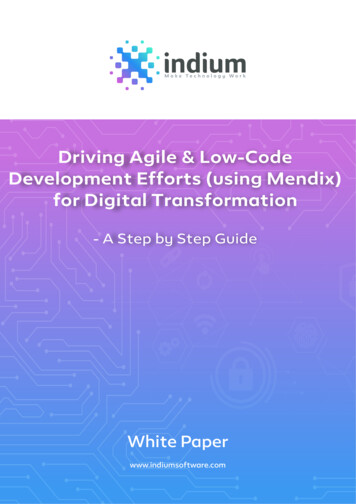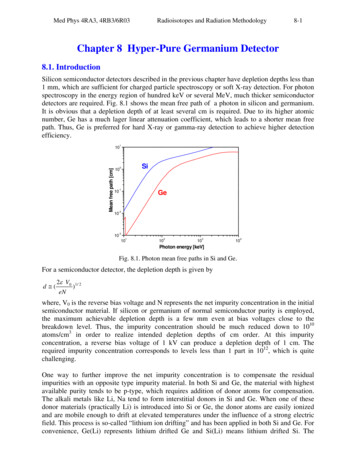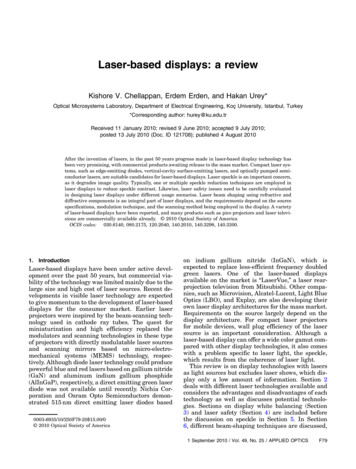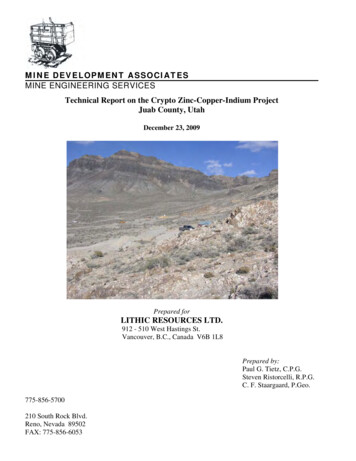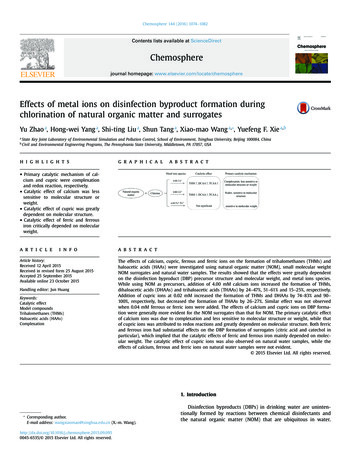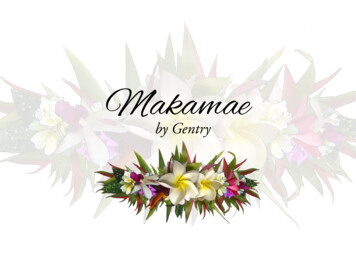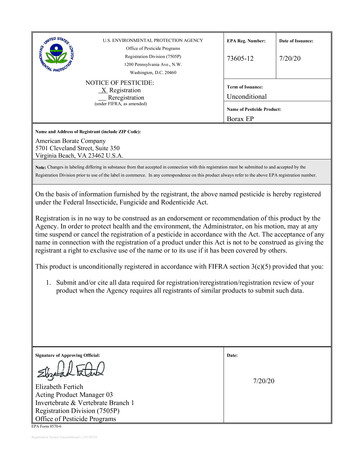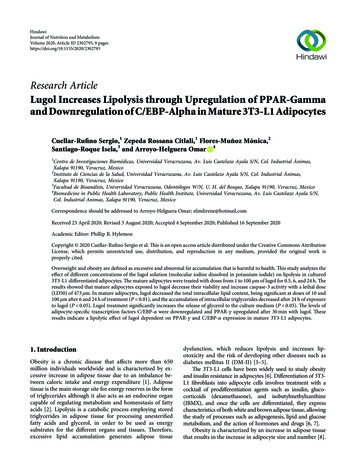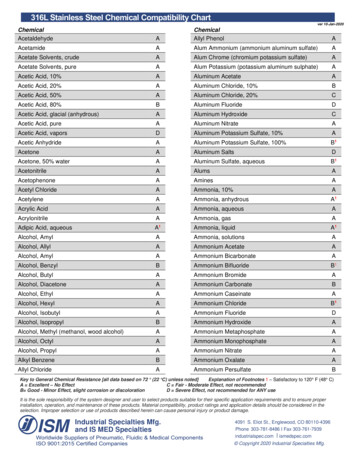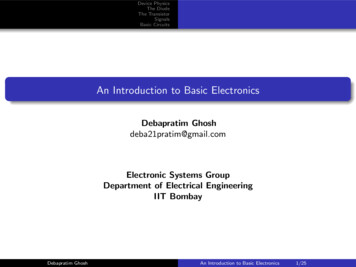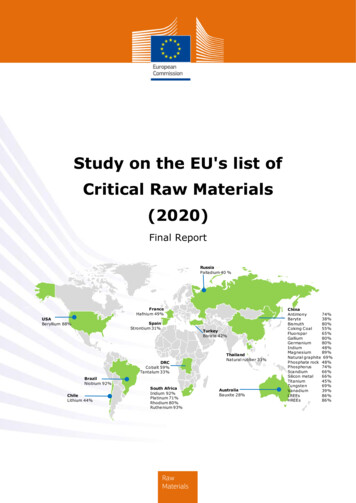
Transcription
Study on the EU's list ofCritical Raw Materials(2020)Final ReportRussiaPalladium 40 %FranceHafnium 49%USABeryllium 88%SpainStrontium 31%TurkeyBorate 42%DRCCobalt 59%Tantalum 33%ThailandNatural rubber 33%BrazilNiobium 92%ChileLithium 44%South AfricaIridium 92%Platinum 71%Rhodium 80%Ruthenium 93%RawMaterialsAustraliaBauxite 28%ChinaAntimony74%Baryte38%Bismuth80%Coking Magnesium89%Natural graphite 69%Phosphate rock 48%Phosphorus74%Scandium66%Silicon REEs86%
Authors: Gian Andrea Blengini, Cynthia EL Latunussa, Umberto Eynard, Cristina Torres de Matos,Dominic Wittmer, Konstantinos Georgitzikis, Claudiu Pavel, Samuel Carrara, Lucia Mancini, ManuelaUnguru, Darina Blagoeva, Fabrice Mathieux, David Pennington.LEGAL NOTICEThis document has been prepared for the European Commission however it reflects the views only of theauthors, and the Commission cannot be held responsible for any use which may be made of the informationcontained therein.More information on the European Union is available on the Internet (http://www.europa.eu).Luxembourg: Publications Office of the European Union, 2020PrintPDFISBN 978-92-76-21050-4ISBN 978-92-76-21049-8doi: 10.2873/904613doi: 10.2873/11619ET-01-20-491-EN-CET-01-20-491-EN-N European Union, 2020EUROPE DIRECT is a service to help you find answersto your questions about the European UnionFreephone number (*):00 800 6 7 8 9 10 11(*) The information given is free, as are most calls (though some operators, phone boxes or hotels may charge you)Reproduction is authorised provided the source is acknowledged.How to cite this report: "European Commission, Study on the EU’s list of Critical Raw Materials (2020)"EUROPEAN COMMISSIONDirectorate-General for Internal Market, Industry, Entrepreneurship and SMEs DG Joint Research CentreDirectorate GROW.C JRC.DUnit GROW.C.2 – Energy-intensive Industries and Raw Materials JRC.D.3 – Land ResourcesContact: GROW.C.2E-mail: GROW-C2@ec.europa.euEuropean CommissionB-1049 Brussels6
Study on the EU's list ofCritical Raw Materials (2020)Final Report31.01.2020ii
EXECUTIVE SUMMARYContextPressure on resources will increase - due to increasing global population,industrialisation, digitalisation, increasing demand from developing countries and thetransition to climate neutrality with metals, minerals and biotic materials used in lowemission technologies and products. OECD forecasts that global materials demand willmore than double from 79 billion tonnes today to 167 billion tonnes in 2060. Globalcompetition for resources will become fierce in the coming decade. Dependence of criticalraw materials may soon replace today's dependence on oil.The EU Green Deal Communication1 adopted on 11 December 2019 recognizes access toresources as a strategic security question to fulfil its ambition towards 2050 climateneutrality and increasing our climate ambition for 2030.Secure and sustainable supply of both primary and secondary raw materials, in particularof critical raw materials, for key technologies and strategic sectors as renewable energy,e-mobility, digital, space and defence is one of the pre-requisites to achieve climateneutrality. The new Industrial Strategy for the EU2 addresses the security andsustainability challenge and calls for an Action Plan on Critical Raw Materials and forindustry-driven raw materials alliances.This continues the work of the Commission to address the growing concern of securingvaluable raw materials for the EU economy. Already in 2008, the European Commissionlaunched the Raw Materials Initiative (RMI)3. This EU policy pursues a diversificationstrategy for securing non-energy raw materials for EU industrial value chains and societalwell-being. Diversification of supply concerns reducing dependencies in all dimensions –by sourcing of primary raw materials from the EU and third countries, increasingsecondary raw materials supply through resource efficiency and circularity, and findingalternatives to scarce raw materials.One of the priority actions of the RMI was to establish a list of critical raw materials at EUlevel. The first list was published in 2011 and it is updated every three years to regularlyassess the criticality of raw materials for the EU. Critical raw materials are considered tobe those that have high economic importance for the EU and a high supply risk.The present study is the fourth technical assessment of critical raw materials for the EU,based on the methodology4 developed by the European Commission in cooperation withthe Ad hoc Working Group on Defining Critical Raw Materials (AHWG)5 in 2017.The first assessment (2011) identified 14 critical raw materials (CRMs) out of the 41 nonenergy, non-agricultural candidate raw materials. In the 2014 exercise, 20 raw materialswere identified as critical out of 54 candidates. In 2017, 27 CRMs were identified among78 candidates.Novelties of the 2020 assessmentThe 2020 assessment covers a larger number of materials: 83 individual materials or 66candidate raw materials comprising 63 individual and 3 grouped materials (ten individualheavy rare earth elements (REEs), five light REEs, and five platinum-group metals(PGMs)). Five new materials (arsenic, cadmium, strontium, zirconium and hydrogen)have been assessed.12345COM(2019) 640 finalCOM(2020) 102 ials/policy-strategy enMethodology for establishing the EU List of Critical Raw Materials, 2017, ISBN 978-92-79-68051-9The AHWG on Defining Critical Raw Materials is a sub-group of the Raw Materials Supply Group expert group.1
Industrial andconstructionmineralsaggregates, baryte, bentonite, borates, diatomite, feldspar,fluorspar, gypsum, kaolin clay, limestone, magnesite, naturalgraphite, perlite, phosphate rock, phosphorus, potash, silicasand, sulphur, talcIron and ferroalloy metalschromium, cobalt, manganese, molybdenum, nickel, niobium,tantalum, titanium, tungsten, vanadiumPrecious metalsgold, silver, and Platinum Group Metals (iridium, palladium,platinum, rhodium, ruthenium)Rare earthsHeavy rare earths (dysprosium, erbium, europium, gadolinium,holmium, lutetium, terbium, thulium, ytterbium, yttrium); Lightrare earths (cerium, lanthanum, neodymium, praseodymiumand samarium); and scandiumOther non-ferrousmetalsBio and othermaterialsaluminium, antimony, arsenic, beryllium, bismuth, cadmium,copper, gallium, germanium, gold, hafnium, indium, lead,lithium, magnesium, rhenium, selenium, silicon metal, silver,strontium, tellurium, tin, zinc, zirconiumnatural cork, natural rubber, natural teak wood, sapele wood,coking coal, hydrogen and heliumFor comparison, 41 candidate materials have been screened in 2011, 54 in 2014 and 61in 2017.ResultsOf the 83 individual (66 candidate) raw materials assessed, the following 30 wereidentified as critical in this ratesCobaltCoking Coal2020 Critical Raw Materials (30)FluorsparMagnesiumGalliumNatural GraphiteNatural ate rockLithiumPhosphorusLREEsScandiumSilicon MetalTantalumTitaniumVanadiumTungstenStrontiumThe overall results of the 2020 criticality assessment are presented in Figure A. Criticalraw materials (CRMs) are highlighted by red dots and are located within the criticalityzone (SR 1 and EI 2.8) of the graph. Blue dots represent the non-critical rawmaterials.2
Figure A: Economic importance and supply risk results of 2020 criticality assessment3
The 2020 list confirms 26 of the 2017 CRMs. Three CRMs in the 2020 list were notconsidered as critical in the 2017 list: Bauxite, Lithium and Titanium. Conversely, Helium,critical in the 2017 CRM list, is no longer in 2020. Strontium is the only new candidatematerial that is in the 2020 list of ing CoalFluorsparGallium2020 CRMs vs. 2017 CRMsGermaniumPGMsHafniumPhosphate rockHREEsPhosphorusLREEsScandiumIndiumSilicon metalMagnesiumTantalumNatural GraphiteTungstenNatural trontiumLegend:Black: CRMs in 2020 and 2017Red: CRMs in 2020, non-CRMs in 2017Green: CRMs assessed in 2020 that were not assessed in 2017Strike: Non-CRMs in 2020 that were critical in 2017The table below summarises the key changes in the 2020 CRMs list compared to the2014 CRMs list. The 2020 assessment confirmed 19 CRMs from the 2014 list, whereas 8of the non-critical materials in 2014 shifted to being critical in 2020.AntimonyBerylliumBorateCobaltCoking CoalFluorsparGalliumGermaniumHREEsLREEs2020 CRMs vs. 2014 ral GraphiteNatural RubberNiobiumScandiumPGMsTantalumPhosphate RockTitaniumSilicon endBlack: CRMs in 2020 and 2014Red: CRMs in 2020 that were not CRMs in 2014Green: CRMs in 2020 that were not included in the assessment in 2014The following tables present the major global supplier of the 2020 critical raw materials.Table A presents the results for individual raw materials. Table B presents the averagedfigures on global primary supply for the 3 material groups: HREEs, LREEs, and PGMs.4
Table A: Major global supplier countries of CRMs – individual tural 9%2930Phosphate rockPhosphorusEPChinaChina48%74%9Coking coalEChina55%31PlatinumPS. 86%11ErbiumEChina86%33RhodiumPS. Africa80%12EuropiumEChina86%34RutheniumPS. ina80%37Silicon %41TungstenPChina69%20IridiumPS. %StageShare89%LREEsE Extraction stage P Processing stageDysprosium, erbium, europium, gadolinium, holmium, lutetium, terbium, thulium,ytterbium, yttriumCerium, lanthanum, neodymium, praseodymium and samariumPGMsIridium, palladium, platinum, rhodium, rutheniumHREEsTable B: Major global supplier countries of CRMs – grouped materials (average)MaterialStageMain global supplierShareHREEsEChina86%LREEsPGMs7 (iridium, platinum, rhodium,ruthenium)PGMs (palladium)EChina86%PSouth Africa75%PRussian Federation40%Figure B is the world map of the main global producers of the raw materials listed ascritical for the EU in 2020.67Stage refers to the life-cycle stage of the material that the criticality assessment was carried out on:extraction (E) or processing (P).Calculating the average for the largest global supplier for all the PGMs is not possible because the majorproducing country is not the same for each of the five PGMs.5
Figure B: Countries accounting for largest share of global supply of CRMsAn analysis of global supply confirms that China is the largest supplier of several criticalraw materials. Other countries are also important global suppliers of specific materials.For instance, Russia and South Africa are the largest global suppliers for platinum groupmetals, the USA for beryllium and Brazil for niobium.Figure C: Main Global supply countries of CRMs8 (based on number of CRMssupplied, average 2012-2016)Spain, 2% Thailand, 2%Russia, 2%France, 2%Turkey, 2%Brazil, 2%Chile, 2%Australia, 3%USA, 3%Congo, DR, 5%South Africa, 9%China, 66%In terms of the total number of CRMs, China is the major global supplier of 66% of theindividual critical raw materials (Figure C). This includes all of the REEs and other criticalraw materials such as magnesium, tungsten, antimony, gallium and germanium amongothers.8The figure should not be interpreted in terms of tonnage of CRM that originate from these countries, but interms of the number of CRMs, for which the country is the main global supplier or producer of the CRM.6
Figure D: EU producers of CRMs, in brackets shares of global supply, 2012201699JRC elaboration on multiple sources7
The following tables present the main countries from which the EU is sourcing critical rawmaterials (EU sourcing). Table C presents the results for individual raw materials. Table Dpresents the averaged figures for 3 material groups: HREEs, LREEs, and PGMs.Table C: Major EU sourcing countries of CRMs – individual Stage10Main ongo,DR68%Coking 353637383940414243PChile78%4422 LithiumLegendStagen/an/aMain EUsupplierSharePChina93%Natural graphiteEChina47%Natural l85%PalladiumPn/aPhosphate mPChinaScandiumPn/aSilicon /a98%100%LREEsE Extraction stage P Processing stageDysprosium, erbium, europium, gadolinium, holmium, lutetium, terbium, thulium,ytterbium, yttriumCerium, lanthanum, neodymium, praseodymium and samariumPGMsIridium, palladium, platinum, rhodium, rutheniumHREEsTable D: Major EU sourcing countries of CRMs – grouped materials (average)MaterialStageMain global /aFigure E is the world map of the main countries from which the EU is sourcing critical rawmaterials (EU sourcing).10Stage refers to the life-cycle stage of the material that the criticality assessment was carried out on:extraction (E) or processing (P).8
Figure E: Countries accounting for largest share of EU sourcing of CRMsDespite China being the largest global supplier for the majority of the critical rawmaterials, the EU sourcing (i.e. domestic production plus imports) paints sometimes adifferent picture (Figure E). The picture of EU sourcing lacks specific data for the fivePGMs, titanium and beryllium. Although China is certainly a major EU supplier (44% ofmaterials, in number, as shown in Figure F), several other countries represent mainshares of the EU supply for specific critical raw materials, such as Brazil (niobium), Chile(lithium) and Mexico (fluorspar).Figure F: Main EU suppliers of CRMs11 (based on number of CRMs supplied,average 2012-2016)United Kingdom,3%Norway, 3%Morocco, 3%Kazakhstan, 3%Guinea, 3%Germany, 3%Finland, 3%Mexico, 3%China, 44%Indonesia, 3%Spain, 3%Brazil, 3%Chile, 3%Australia, 3%France, 6%Turkey, 6%Congo, Dem. Rep.,6%All raw materials, even if not considered critical, are important for the EU economy. Thefact that a given material is classed as non-critical does not imply that availability andimportance to the EU economy can be neglected. Moreover, the availability of new dataand possible evolutions in EU and international markets may affect the list in the future.11The figure should not be interpreted in terms of tonnage of CRM that originate from the countries, but interms of the number of CRMs, for which the country is the main supplier for the EU.9
TABLE OF CONTENTS1.INTRODUCTION . 121.1.1.2.1.3.1.4.1.5.1.6.2.CRITICALITY ASSESSMENT APPROACH . 182.12.22.32.43.Content and purpose of this report . 12Objectives of this report . 12The purpose of the list of critical raw materials . 13The importance of raw materials in Europe . 14The challenge of critical raw materials in Europe . 16Addressing critical raw material challenges . 16Scope & materials covered . 18The EC criticality methodology . 20Data collection and sources . 20Stakeholder consultation . 21CRITICALITY ASSESSMENT OUTCOME . 233.1Criticality assessment results . 233.22020 List of Critical Raw Materials. 283.3Comparison with previous assessments . 303.4Key findings of the criticality assessments . 323.5Limitations of the criticality assessments . 443.6Recommendations for future assessments. 45Abbreviations and glossary . 48Specific abbreviations for the materials covered . 49Glossary . 50ANNEXES . 53Overview of international criticality methodologies and assessments . 53Stages assessed and rationale . 56Additional details on the criticality assessment results . 62Substitution indexes . 67End uses, NACE2 sectors assignement . 68Global supply, trade-related varialble and WGI (2 stages). . 88EU Sourcing, trade-related varialble and WGI (2 stages). . 116Summary report of the stakeholder validation workshops . 139Key authors and contributors . 15210
LIST OF TABLESTable 1: List of materials/groupings covered in the 2020 assessment . 18Table 2: List of materials covered by a double-stage supply risk assessment . 19Table 3: Scoring matrix to evaluate quality of EU supply data . 21Table 4: Criticality assessment results (individual materials, grouped materials) . 23Table 5: 2020 Critical raw materials for the EU . 28Table 6: Key changes to the 2020 list of CRMs compared to the 2017 CRMs list . 30Table 7: Materials identified as critical in 2011, 2014, 2017 and 2020 assessments . 30Table 8: Criticality assessment results for new materials . 34Table 9: Stages assessed as critical for the 2020 critical raw materials . 35Table 10: Global supply of the CRMs, individual materials . 35Table 11: Global supply of grouped CRMs, arithmetic average . 36Table 12: CRMs with China as the largest global supplier but not as largest EU supplier . 38Table 13: Materials with negative or zero Import reliance . 43Table 14: Summary of conclusions and recommendations . 46Table 16: Comparison of SR results based on scope of supply data used . 62Table 17: Comparison of 2020 results and previous assessments . 64Table 18: Individual and average EI and SR scores for material groups – LREEs, HREEs and PGMs . 66Table 19: Organisation of the stakeholder workshops . 147Table 20: Validation workshops attendance list . 149LIST OF FIGURESFigure 1: Main global suppliers of all candidate critical raw materials assessed, (based on numberof raw materials supplied, average from 2012-2016).15Figure 2: Overall structure of the revised criticality methodology.20Figure 3: SR and EI results for the individual materials grouped as PGMs, LREEs and HREEs .25Figure 4: SR and EI results, individual materials and grouped materials .26Figure 5: SR and EI results for individual non-grouped and grouped materials (HREEs, LREEs andPGMs) .27Figure 6: Criticality assessment results (individual materials and groups) .29Figure 7: 2020 Criticality assessment results compared to the 2017 assessment .31Figure 8: Main global suppliers of CRMs (based on number of CRMs supplied), average from2012-2016 .37Figure 9: Main EU sourcing countries of CRMs (based on number of CRMs supplied), averagefrom 2012- 2016 (REEs 2016-2018).37Figure 10: Comparison of SR results based on scope of supply data used .39Figure 11: Comparison of SR results based on scope of supply data used (double stage) .40Figure 12: EOL-RIR .41Figure 13: Import reliance .42Figure 14 Frequency of appearance in criticality assessments and criticality determination (high,medium, or low) of materials (Schrijvers et al., 2019). .5511
1. INTRODUCTION1.1.CONTENT AND PURPOSE OF THIS REPORTThis joint GROW and JRC report ‘Study on the review of the list of Critical Raw Materials’serves as the background document in support of the 2020 list of CRMs for the EU.The present report is the result of intense cooperation with the Ad hoc Working Group onDefining Critical Raw Materials (AHWG12), consultants and key industry and scientificexperts identified through the H2020 SCRREEN13 project.This report includes information on the criticality assessments carried out on thematerials covered for this 2020 exercise. Further information is presented in thematerials factsheets14, for both critical and non-critical materials. These factsheets areprovided as separate documents and are available in the EC's Raw Materials InformationSystem (RMIS)15.The present report is divided into the following chapters and annexes: Chapter 1 – Introduction to the report: objectives and context of critical rawmaterials in Europe; Chapter 2 – Criticality assessment approach: scope of the criticality assessments,application of the EC criticality methodology, data sources used and stakeholderconsultation; Chapter 3 – Criticality assessment outcome: results and key findings, comparisonwith previous assessments and limitations of the assessment results, conclusionsand recommendations; and Annexes – Additional supporting information on the methodology, internationaldevelopments, quantitative assessment and related data, stakeholder consultations1.2.OBJECTIVES OF THIS REPORTThis report presents the results of the assessment of the criticality of 83 raw materialsfor the EU based on the revised methodology developed by the European Commission(DG GROW and DG JRC)16. The report builds upon the work carried out in the previousassessments (201117, 201418 and 201719). The report takes into account feedbackgathered from the previous and 2020 exercises, and in doing so, establishes the basis forthe updated list of critical raw materials for the EU.The AHWG on Defining Critical Raw Materials is a sub-group of the Raw Materials Supply Group expert group.The list of its members and observers is available dex.cfm?do groupDetail.groupDetail&groupID 135313http://scrreen.eu/the-project/14The factsheets for critical and non-critical materials are provided as separate documents and are availablethrough the RMIS. A total of 68 factsheets, corresponding to the 83 candidates (including both individualmaterials and groups) are included. The breakdown of the 68 factsheets are as follows: 64 individual material factsheets 1 individual factsheet for Aluminium (metal and bauxite) 1 individual factsheet for Phosphorus (phosphorus and phosphate rock) 1 grouped factsheet for the REEs (with sections dedicated to single elements) 1 grouped factsheet for the PGMs15https://rmis.jrc.ec.europa.eu/16Methodology for establishing the EU List of Critical Raw Materials, 2017, ISBN 978-92-79-68051-9172011 assessment refers to the study on Critical Raw Materials for the EU published in 2010 and theCommission's Communication COM(2011)25 adopted in 2011.182014 assessment refers to the study on Critical Raw Materials at EU level published in 2013 and theCommission's Communication COM(2014)297 adopted in 2014.192017 assessment refers to the study on Critical Raw Materials at EU level published in 2016 and theCommission’s Communication COM(2017)0490 final adopted in 2017.1212
The operational objectives of this study were to: Assess the criticality of a selection of raw materials based on the EC criticalitymethodology.Analyse the production, key trends, trade flows and barriers of the rawmaterials with the aim to identify potential bottlenecks 20 and supply risksthroughout the value chain. To the extent possible, data and projections arebased on the reference period of the last 5 years in terms of data availability.Produce qualitative factsheets for all the raw materials assessed.Produce full datasets, calculation sheets and comprehensive list of datasources in an excel-compatible format.Continue to improve the quality and availability of data.Cooperate with both EU and non-EU experts (where relevant) to improve thefindings of the study.Collaborate with the expert group 'Ad hoc Working Group on Defining CriticalRaw Materials'21 and with the SCRREEN22 expert group.In particular, the 2020 assessment incorporates the following aspects: 1.3.Analysis of a wider range of raw materials (5 new candidates);Introduces a systematic two-stage supply chain assessment of the supply risk(mining/extracting and processing/refining stages);Updated factsheets for each of the materials assessed to include informationon the supply chain, the criticality assessment and future trends;Optimise data quality and transparency, in respect to the hierarchy of datasources identified in the EC methodology, both in the assessments andfactsheets; andBetter coordination with parallel efforts to develop further Material SystemAnalyses23, as the priority data source for e.g. recycling data (EOL-RIR).THE PURPOSE OF THE LIST OF CRITICAL RAW MATERIALS FOR THE EUThe assessment and the list of critical raw materials are intended to flag the supply risksof important materials for the EU economy. They contribute to securing thecompetitiveness of the EU industrial value chains starting with raw materials in line withthe EU industrial policy. This should increase the overall competitiveness of the EUeconomy, in line with the Commission s priorities. It should also help incentivise theEuropean production of critical raw materials and facilitate the launching of new miningand recycling activities. The list is also being used to help prioritise needs and actions.For example, it serves as a supporting element when negotiating trade agreements,challenging trade distortion measures or promoting research and innovation actions.It is also worth emphasising that all raw materials, even if not classed as critical, areimportant for the European economy and that a given raw material and its availability tothe European economy should therefore not be neglected just because it is not classed ascritical.A bottleneck is considered to be the point in the value chain for a specific material where the supply risk ishighest, i.e. the stage (either extraction/harvesting or processing/refining), that has the highest numericalcriticality score for the Supply Risk.21The consultants have provided scientific and technical support to the Commission throughout the course ofthe study, incorporated relevant comments and feedback, provided updates on the advancement of the work,and presented the findings of the assessment in the final report of the study on "Critical Raw Materials for theEU" and the publication of the new list of Critical Raw Materials.22http://scrreen.eu/the-project/23As part of a broader project, JRC
industrialisation, digitalisation, increasing demand from developing countries and the transition to climate neutrality with metals, minerals and biotic materials used in low- . The new Industrial Strategy for the EU2 addresses the security and . critical in the 2017 CRM list, is no longer in 2020. Strontium is the only new candidate
